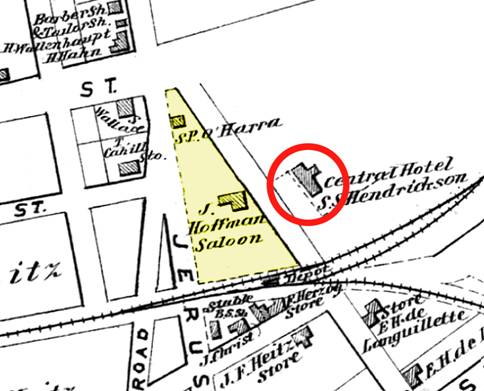Hicksville Once Was the Railroad's Town
The Triangle Vicinity in 1873
Atlas of Long Island, etc., Beers, Comstock & Cline, 1873 (excerpt)
digitalcollections.nypl.org
In any number of old towns in the Eastern U.S., people can point at something and lament, "It was never the same once the railroad came." It may seem disingenuous for Hicksvillians to do that - after all, the railroad was there first, and the original settlers chose to live and work right on top of it. Nonetheless, it is fair to observe that as time went by, the LIRR had to encroach - and it did encroach - on the village, and its spread critically affected things that had been established close to the tracks.
Railroading steadily matured in the 19th century, and the things it did got faster and a lot bigger. As longer trains ran more frequently between Jamaica and points east, each carrying more people than Valentine Hicks could ever have imagined, the towns and villages that depended on the railroad had to withstand many changes. Yet, look at the meager LIRR infrastructure (basically only track, albeit with a small depot and platform) that existed as late as the 1870s. It was nearly identical to how things had existed from the start. After 40 years, nothing built or laid out in Hicksville was closer to the railroad than in 1837.
Change was overdue. Because the Main Line between Hicksville and Jamaica had two-way traffic, but much of it was still only a single track, demand was pushing closer to capacity. Thanks to the Island's prosperity, more goods and produce were being shipped as freight, but there was little room for handling freight at Hicksville. A future rail connection to Manhattan was inevitable, and when it happened, the need for still longer passenger trains, and more of them, would increase sharply. For all these reasons, the railroad needed larger locomotives, and they would burn more fuel, and use more water - things which had to be stored not only at Jamaica, but also at key points to the east.

A view which existed for only one year: looking west from Broadway
at the 19th century depot and the LIRR water tank.
https://nyheritage.org(source unconfirmed as of this writing)
The tank was constructed in 1908, and the depot removed in 1909.
Thus, between the 1880s and 1916, a series of projects nibbled away at the properties that adjoined the LIRR, netting these results:
- The little depot no longer stood near Broadway.
- A second track, adjacent to and north of the original, had been added to the Main Line, all the way from Jamaica.
- Immediately west of Jerusalem Avenue, a new passenger station had been erected.
- To the west of the new station, the old LIRR property line had been pushed north, far enough into the properties on Barclay Street to accommodate a yard that could hold more than 120 boxcars. It had a freight depot and a Railway Express Agency (think FedEx on rails) facility.
- With the new yard facilities in the way, Newbridge Road could no longer continue north across the tracks; it had been rerouted, so as to curve right and subsume Herzog Place.
- In the Triangle, some distance north of the tracks, there now stood a 50,000 gallon water tank, used exclusively to replenish locomotives' water supplies.
***

